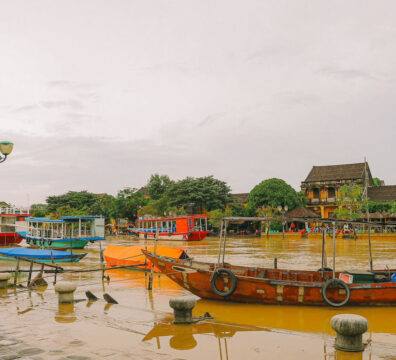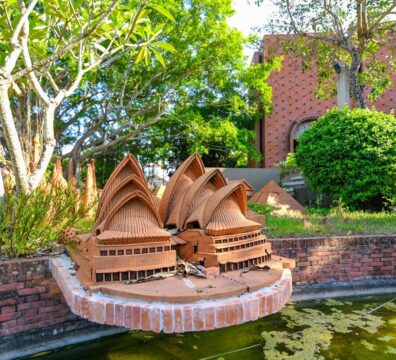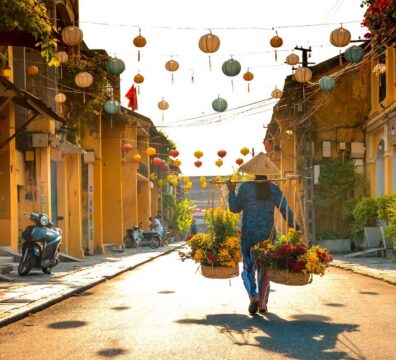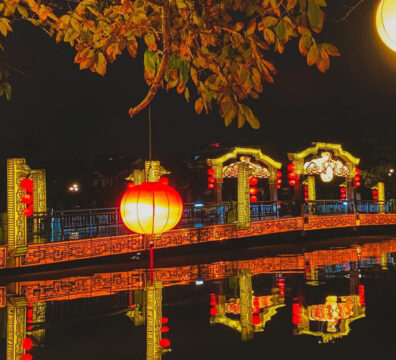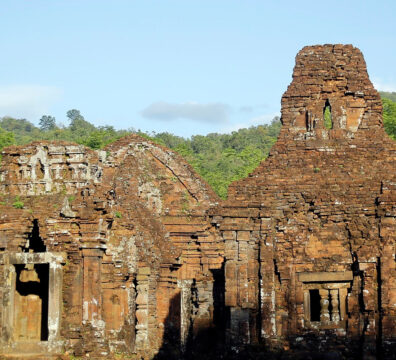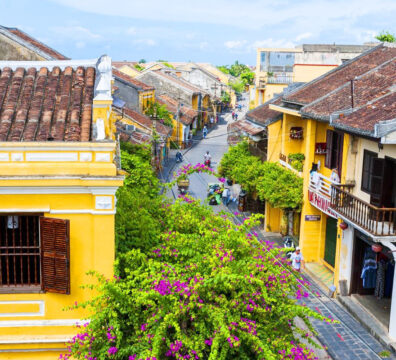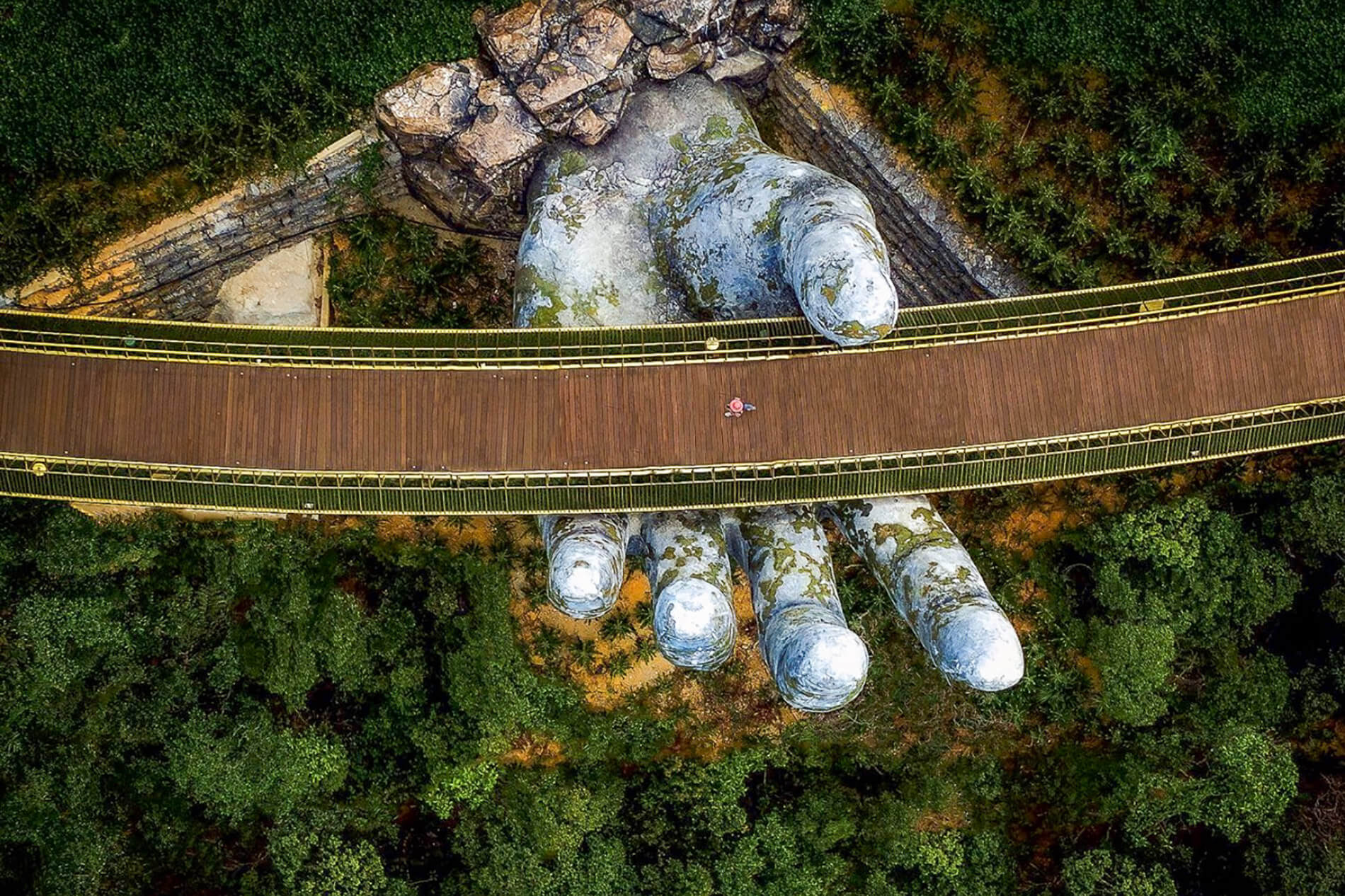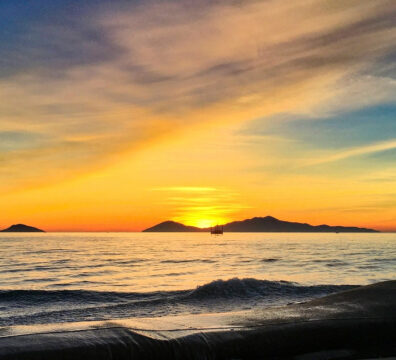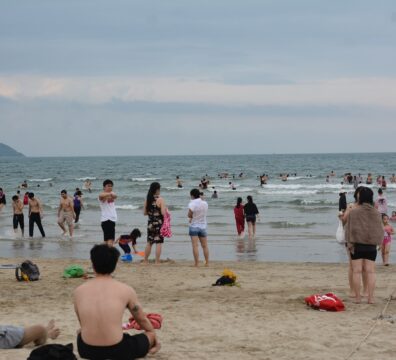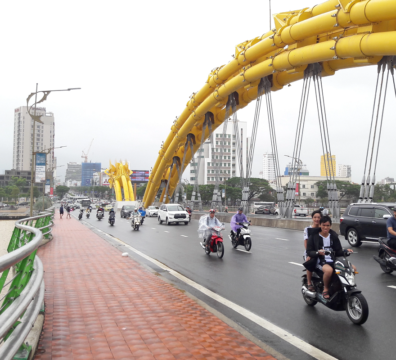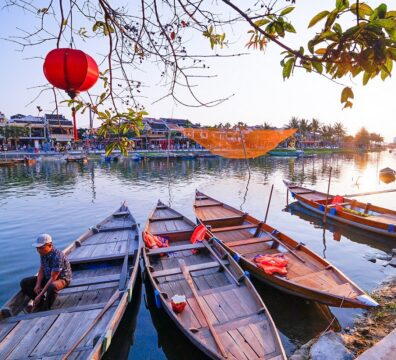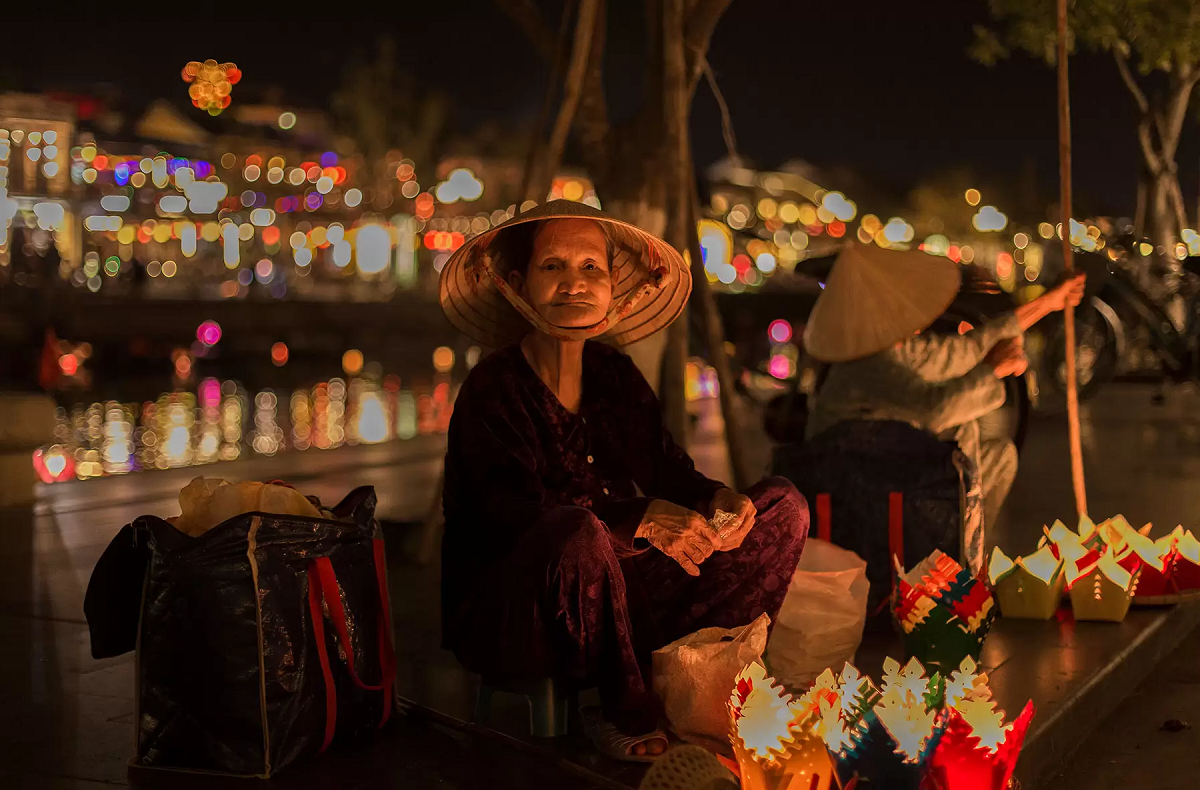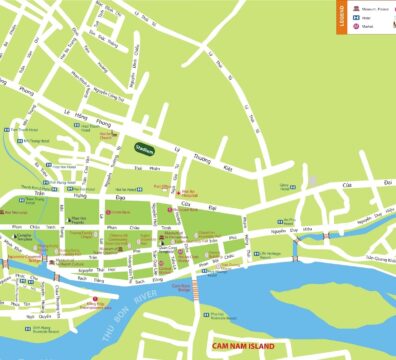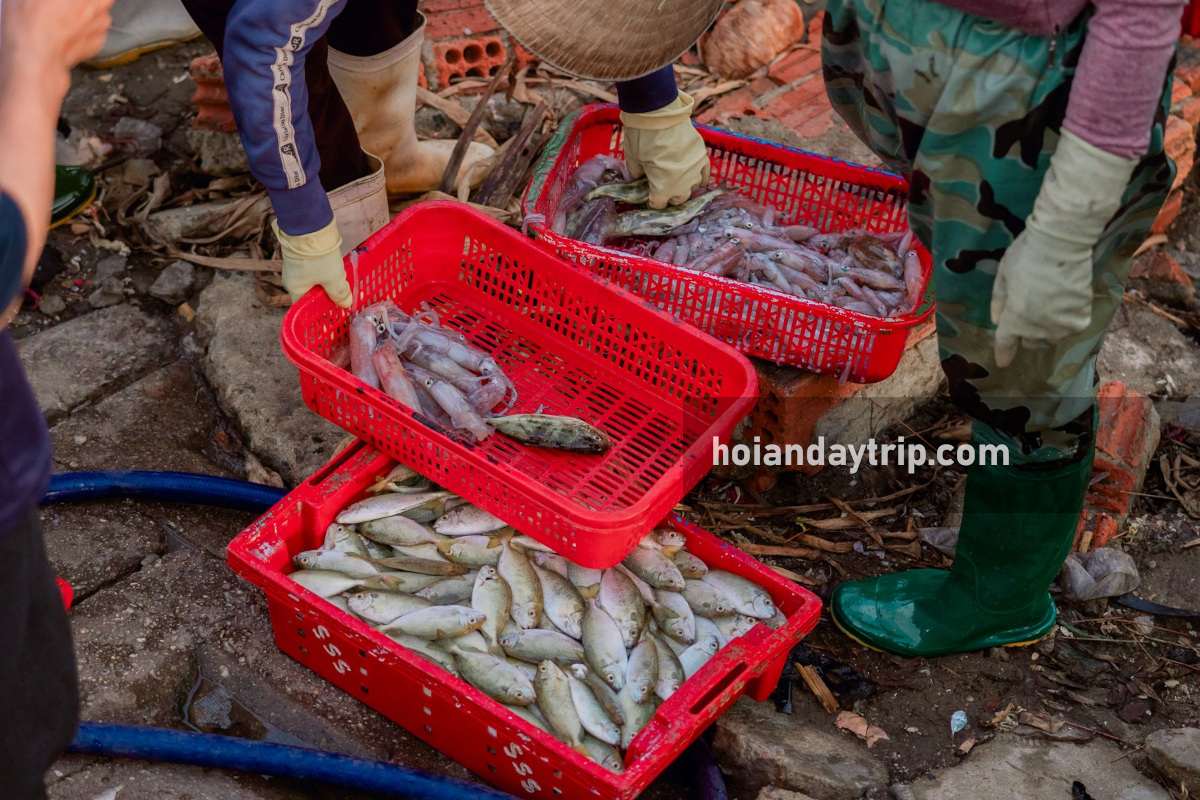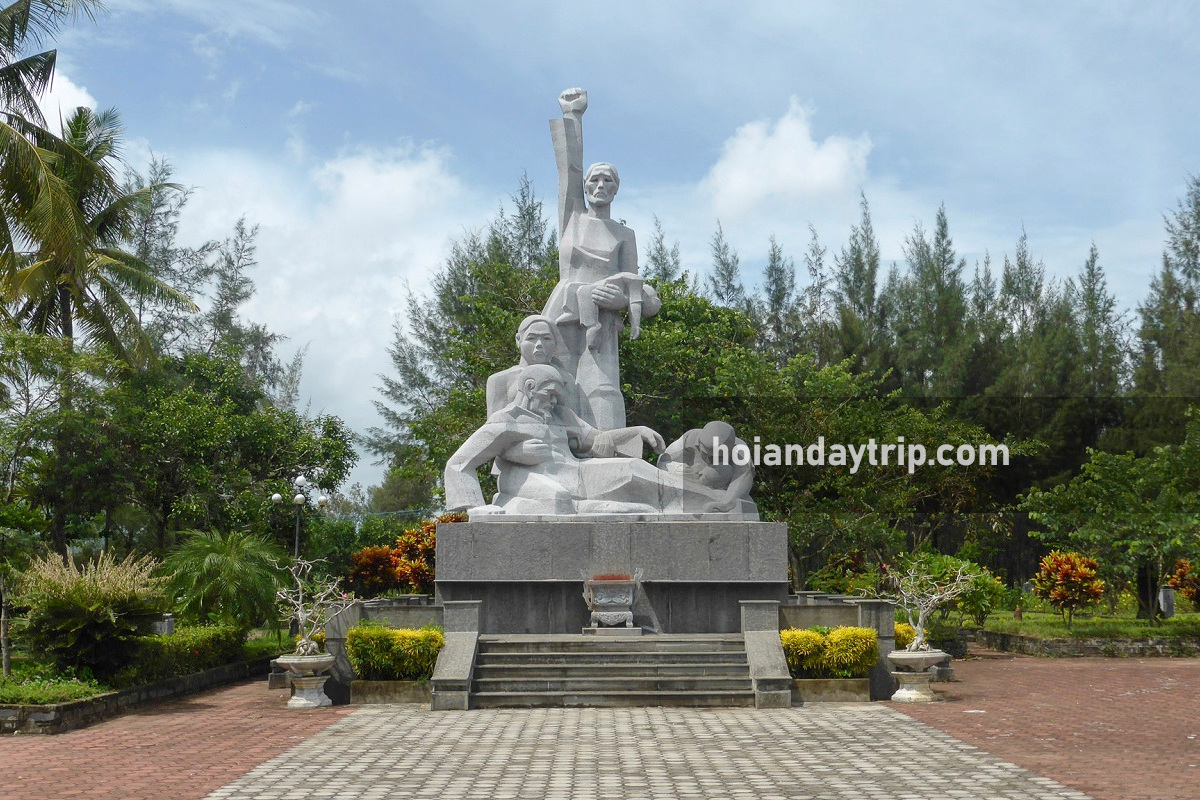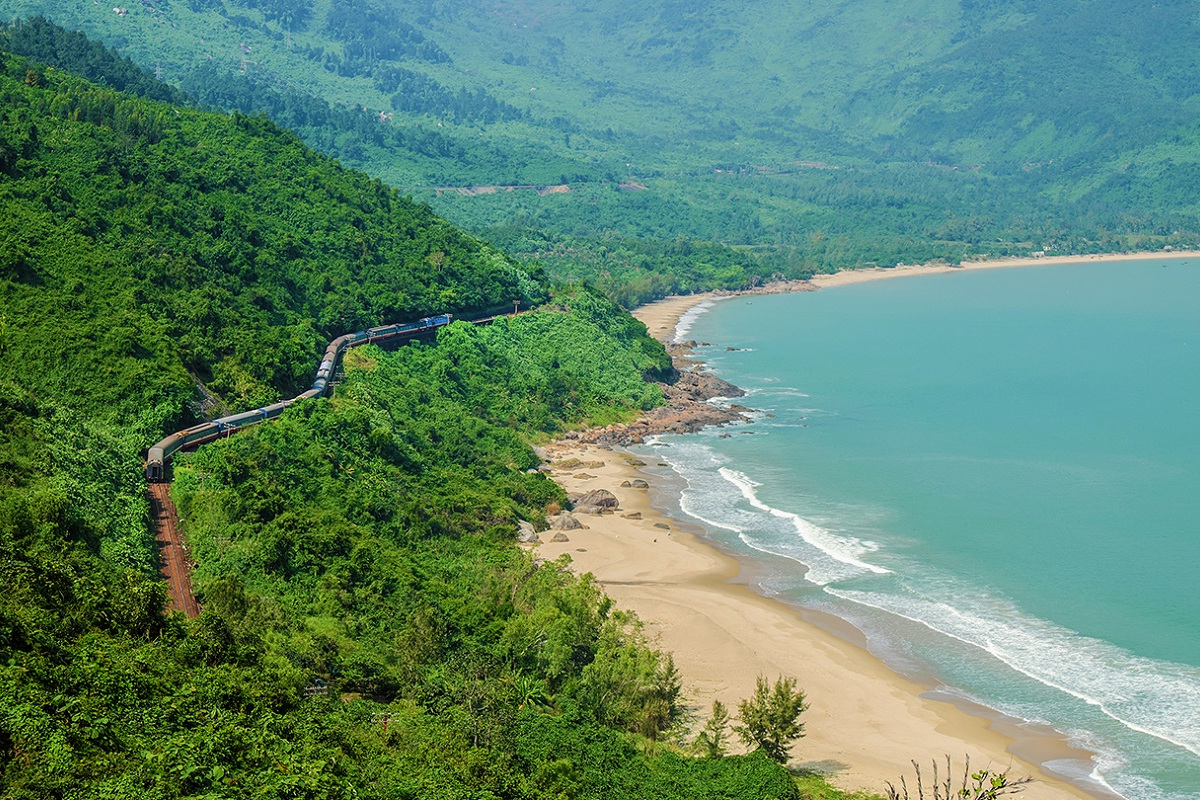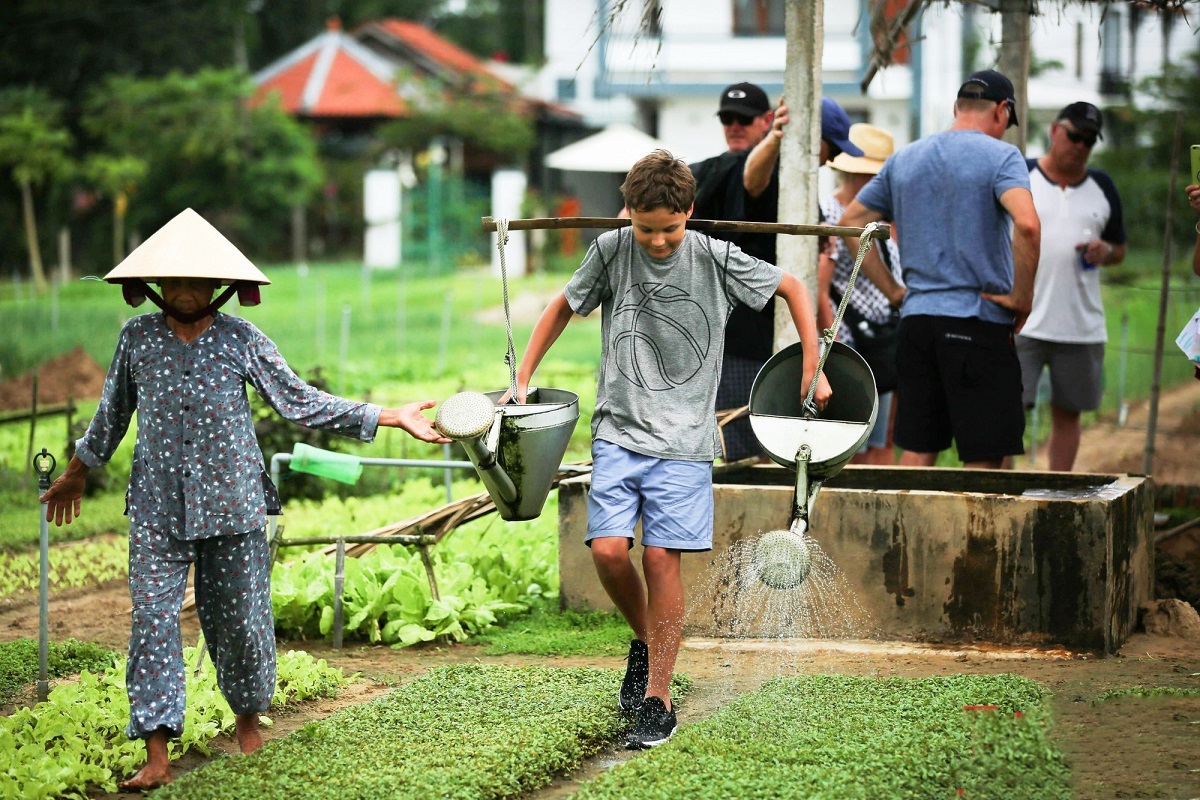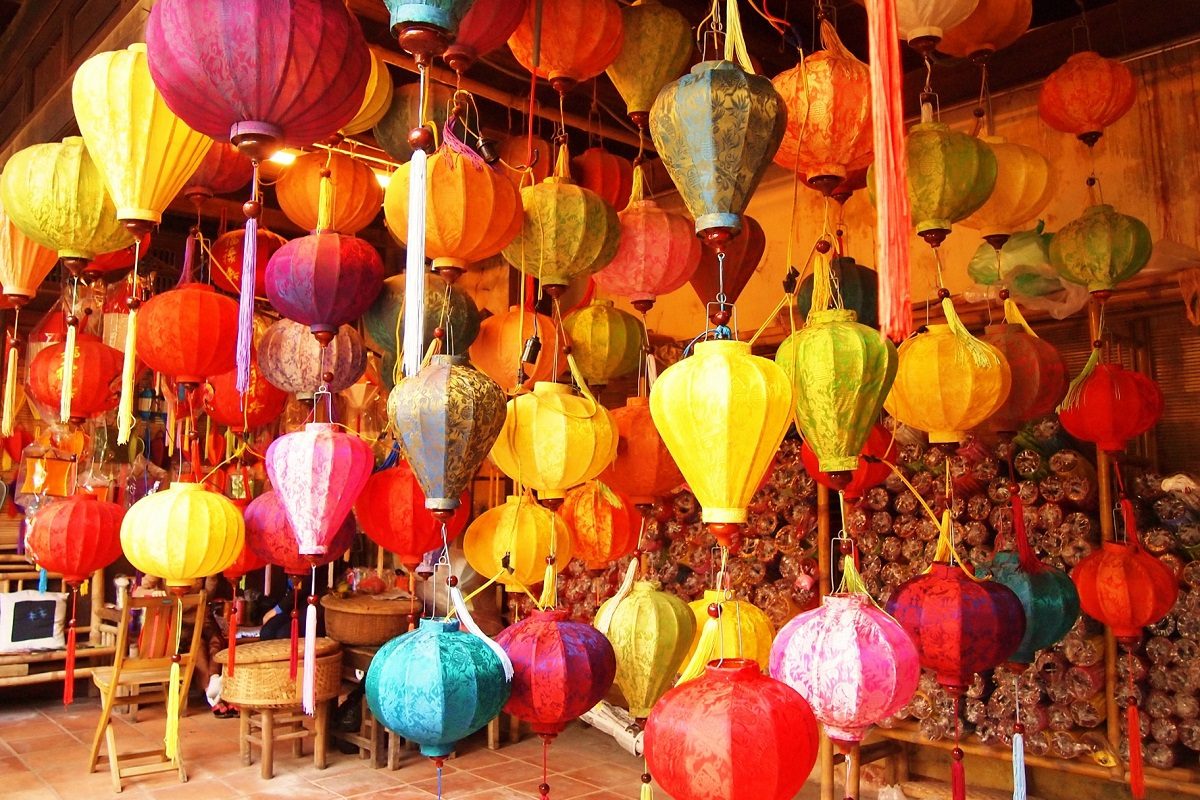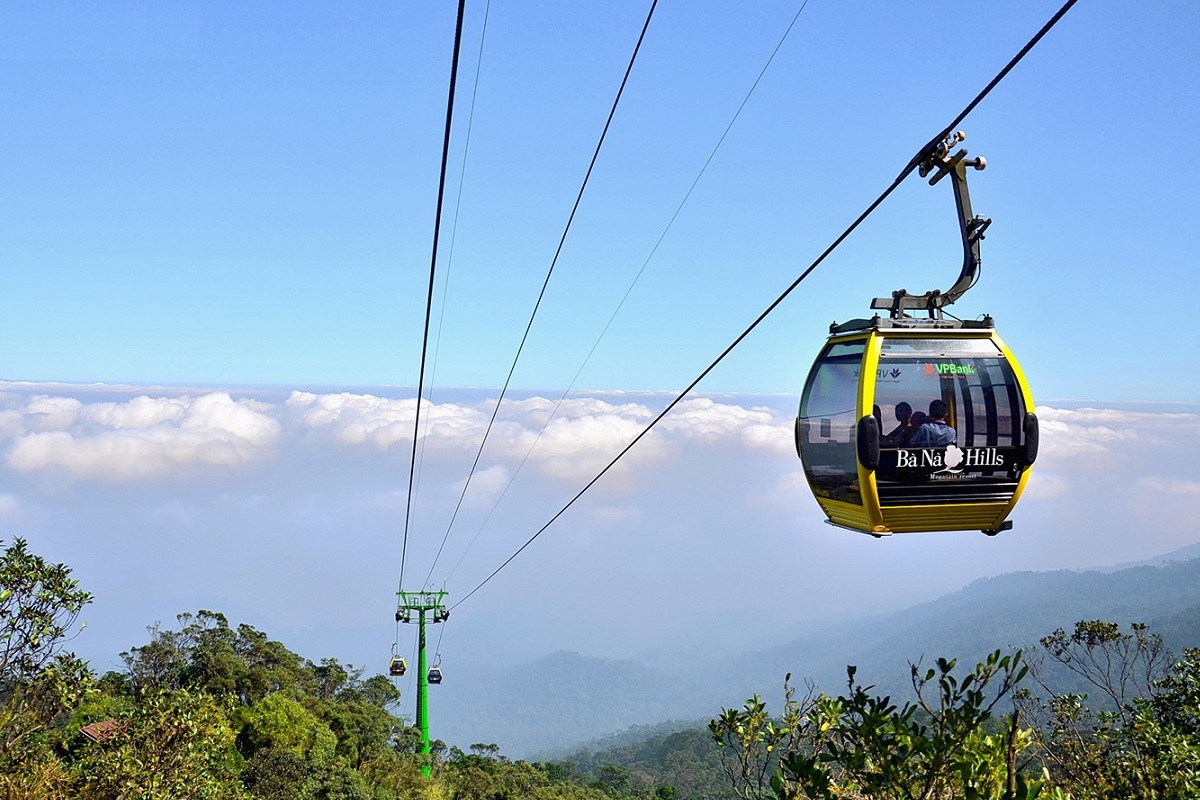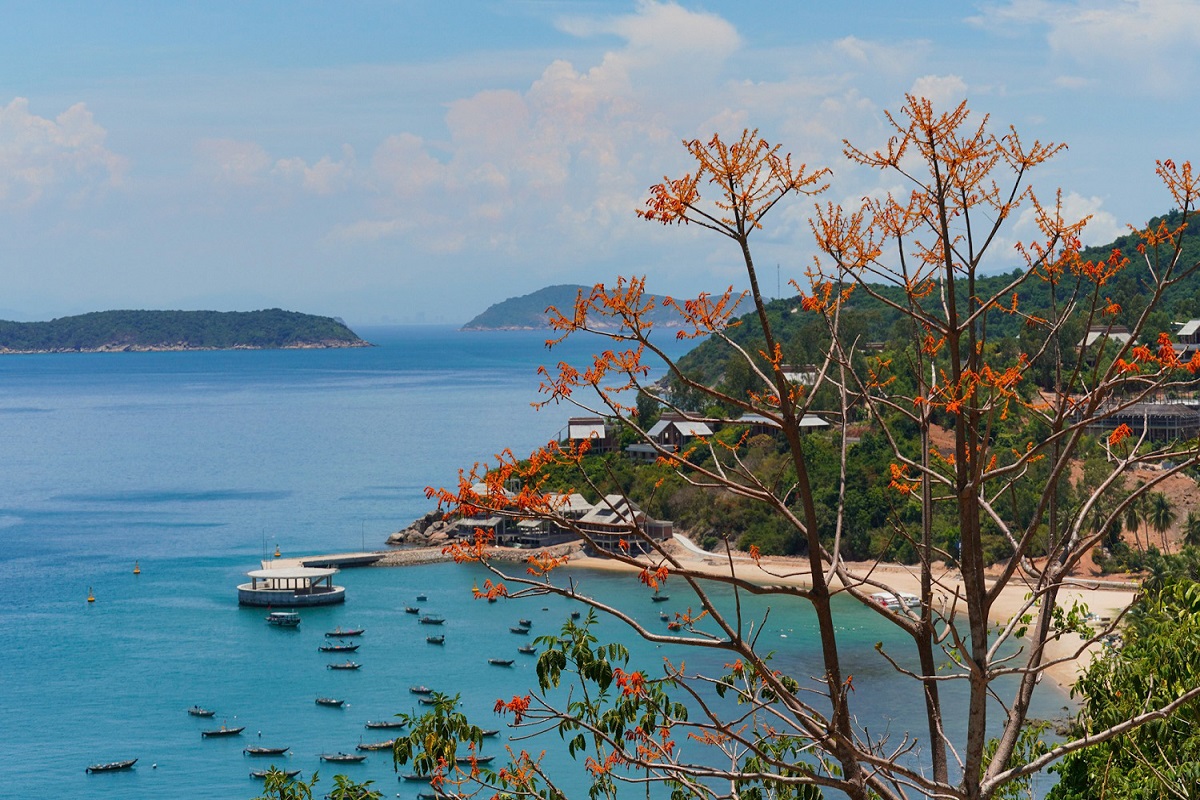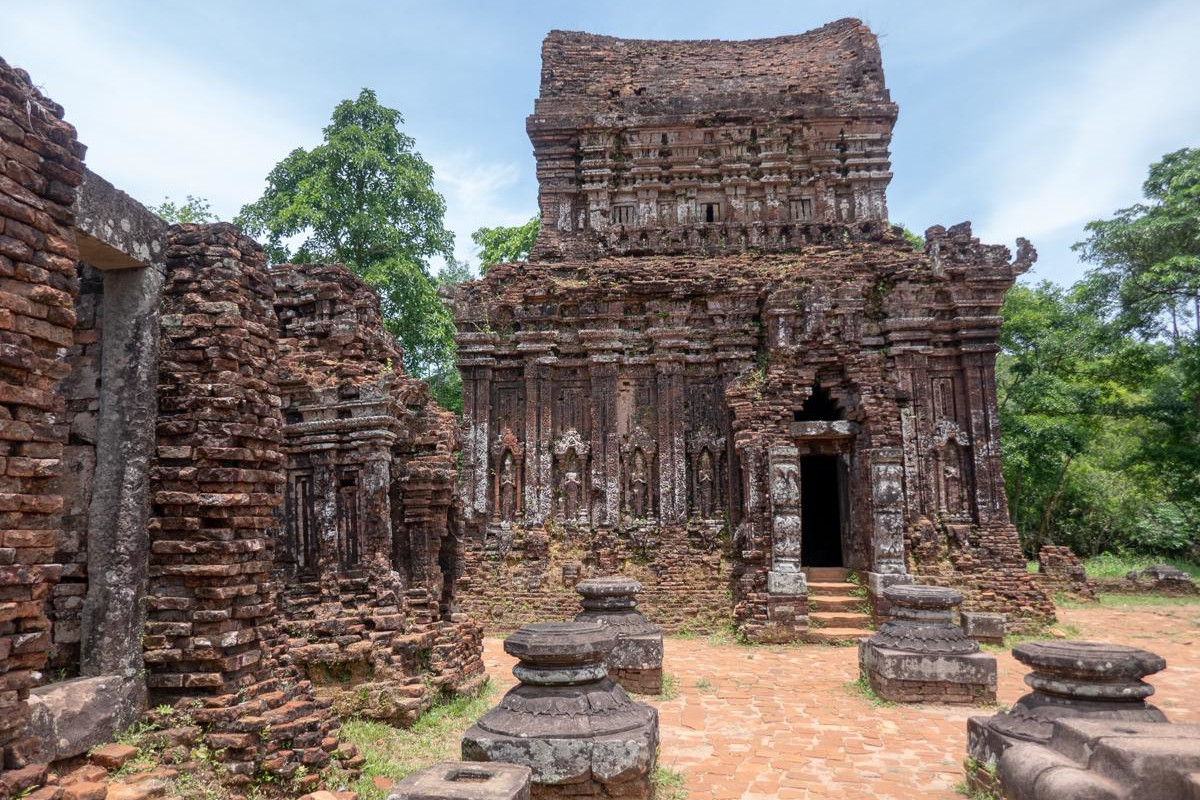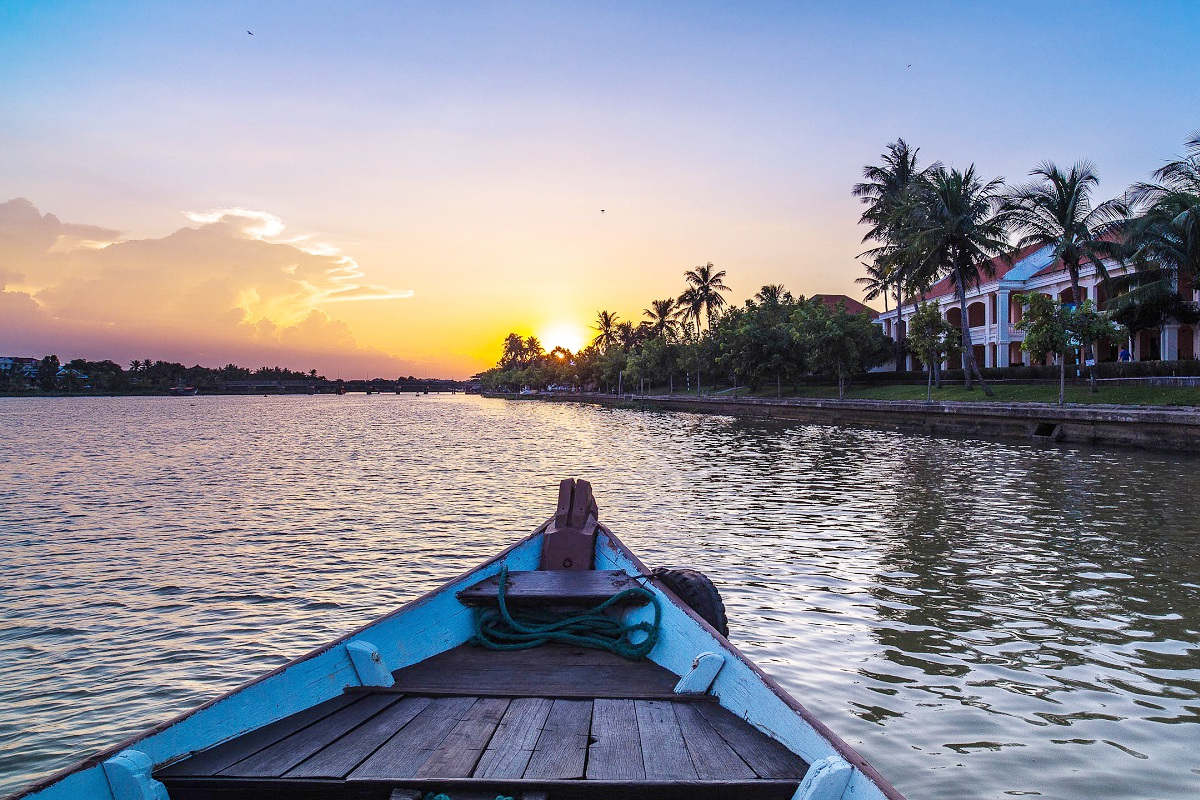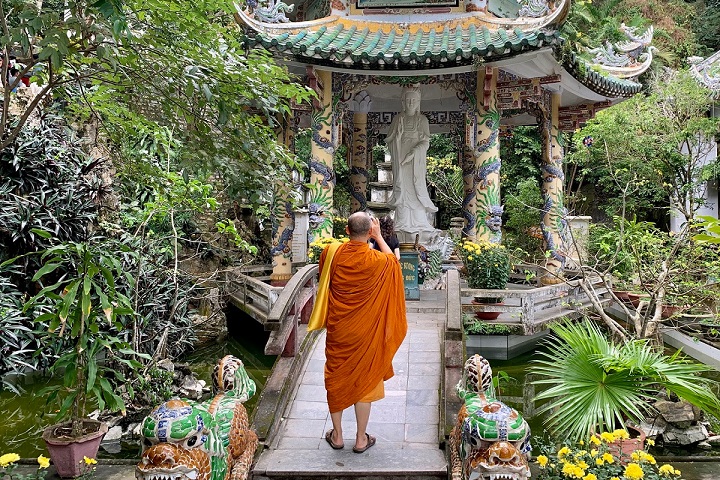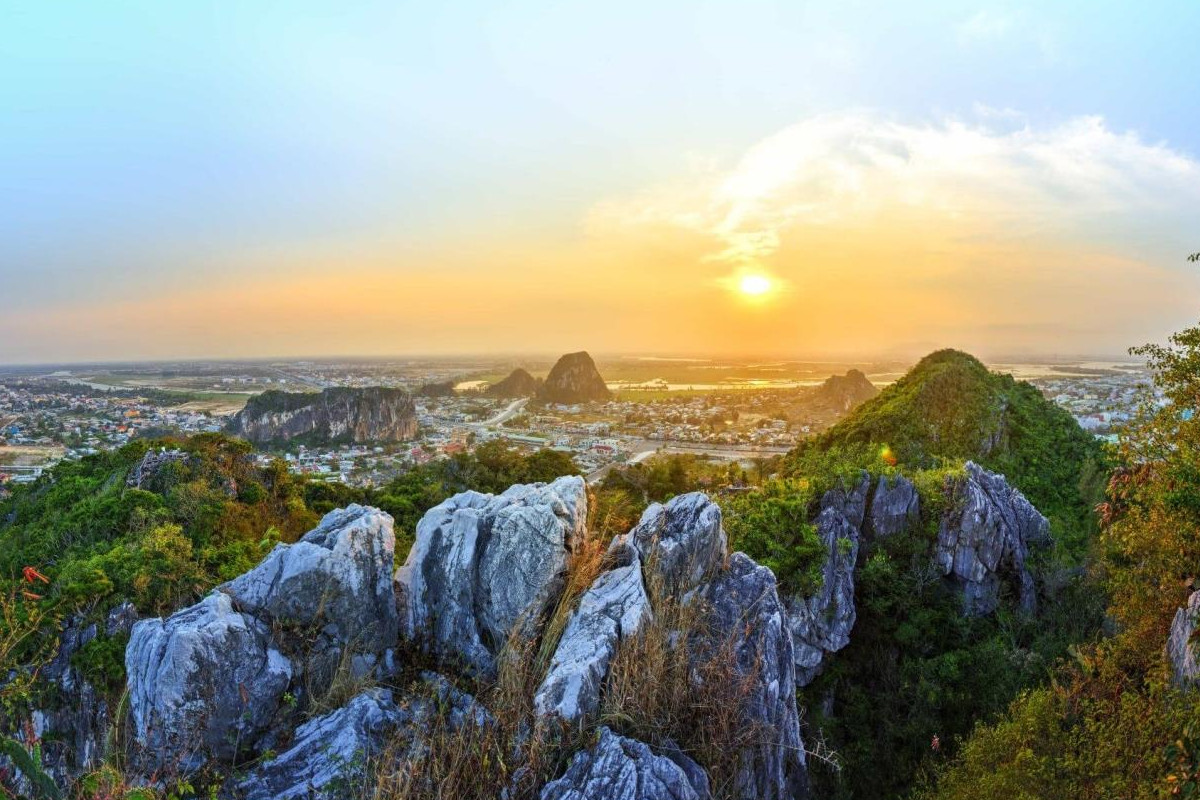The purple islands seen from An Bang or Cua Dai beaches are the Cham Islands. It’s one of the kind in the region where God bless it with fabulous beautiful coral reefs with a diversity of marine life. In 2009, the government announced it as a national marine park, and ten years later, the Unesco approved adding it to the World Biosphere Reserve list. No surprise, this is one of the places that must be visited once in the lifetime for local snorkelers and divers. If lucky, you may make history when discovering a shipwreck with plenty of luxury porcelains. On the ground, sandy beaches with sunbeds under the coconut palms, historical sites and an authentic lifestyle of the islanders, definitely await visitors to come and explore. The best seafood dishes in Hoi An are sold along small roads in fisherman hamlets nearby.
This ultimate travel guide provides everything you need to know about Cham Island in Hoi An. All necessary information is outlined, for guided and self-guided travelers, and for every time of the year. Because the island is really nice to stay back, relax and discover, we made our own guide for Cham Island accommodation. It aims to inform the best villages, friendly host to lodge and what to see, do and eat for stayers. One of the most wonderful things is being away from crowds.
Read also:
- Hoi An Old Town Travel Guide
- Beaches in Hoi An
- An Bang Beach Guide
- Cua Dai Beach

Table of content
- 1 About Cham Island in Hoi An
- 2 History of Cham Island
- 3 Cham Island Weather & Best Time to Visit
- 4 Cham Island Entrance Fee and Ticket
- 5 Activities in Cham Island
- 6 How to Get to Cham Island
- 7 Cham Island Tour
- 8 Cham Island Restaurants
- 9 Cham Island Accommodation
- 10 Cham Island on Google Maps
- 11 Related Posts
- 12 Bach Ma National Park: Hiking, Trekking in Da Nang and Hoi An
- 13 Hoi An Wet Season: What to Do in Hoi An When It Rains?
- 14 Thanh Ha Terracotta Park
- 15 Vinwonders Nam Hoi An Theme Park (formerly Vinpearl Nam Hoi An)
- 16 Am Phu Cave (Hell Cave) – Things to Do in Da Nang
- 17 Hoi An or Hue: Which is Better?
- 18 The Official Hoi An Travel Guide (MUST READ)
- 19 The Hoi An Market (Hoi An Central Market) Complete Guide
- 20 Hoi An Memories Show: The Best of Hoi An Impression Theme Park
- 21 Hoi An Bridge: Famous Bridges in Hoi An
- 22 How to Get From Hoi An to My Son Sanctuary
- 23 Hoi An’s Chinese Assembly Halls and Chinese Temples
- 24 Hoi An Walking Tours: Heritage, Foods, Photography & Locals
- 25 Hoi An Self Guided Walking Tour – Hoi An On Your Own
- 26 How to Visit Golden Bridge Vietnam
- 27 Unique Experiences in Hoi An and Why?
- 28 An Bang Beach: A Guide to Hoi An’s Best Beach
- 29 Experiences in Hoi An: Get Insight Into Hoi An’s Local Culture
- 30 Things to Do in Ba Na Hills Besides Golden Bridge
- 31 Hoi An Nightlife: What to Do in Hoi An At Night?
- 32 Hoi An Countryside: Villages, Rice Fields & Tours
- 33 How to Get to Golden Bridge From Hoi An
- 34 Hoi An Entrance Fee: Old Town, Golden Bridge, My Son, More
- 35 Hoi An Airport: Everything You Need to Know
- 36 Hoi An Lantern Boat Ride on Hoai River
- 37 Hoi An Private Car and Driver
- 38 What to Do in Hoi An Ancient Town
- 39 Da Nang and Hoi An Itinerary for Visitors Staying Overnight in Hoi An
- 40 Hoi An 3 Day Itinerary: A Travel Plan for 3 Days in Hoi An
- 41 Hoi An Free Things to Do: Budget Travel in Hoi An Vietnam
- 42 Hoi An One Day Itinerary: A Travel Plan for One Day in Hoi An
- 43 Hoi An Half-Day Tours: Guide to Half Day Trips From Hoi An
- 44 Hoi An Day Tours: A Guide to Best Day Trips From Hoi An
- 45 Hoi An Beach: A Guide to All Beaches in Hoi An Vietnam
- 46 Hoi An Food Specialties
- 47 How to Get From Hoi An to Da Nang
- 48 Hoi An Cheap Things to Do: All Solo Travelers Need to Know
- 49 Hoi An Best Things To Do: Recommendations from Local Experts
- 50 Hoi An Things to Do: All What Can You Do in Hoi An Vietnam
- 51 Hoi An Things Not to Miss: A Guide to Must Do in Hoi An
- 52 Hoi An or Da Nang: Which is Better for First Time Visitor?
- 53 Hoi An Pottery Village: A Guide to Thanh Ha Pottery Village
- 54 Hoi An Ancient Town Tour
- 55 Hoi An Old Town Ticket: Price, Sellers, Included Sites, More
- 56 My Son Sanctuary Tour
- 57 Hoi An Lanterns: Festival, Making Class, Where to Buy, More
- 58 Hoi An Best Area to Stay: Guide to Where to Stay in Hoi An
- 59 Hoi An Weather by Month: Guide to Hoi An Monthly Weather
- 60 Hoi An River Cruise: Guide to The Best Boat Tour in Hoi An
- 61 Hoi An Old Town Boats: Guide to Boat Rides in Hoi An Town
- 62 Hoi An 2 Day Itinerary: Traveler Guide to 2 Days in Hoi An
- 63 Cham Island Hoi An
- 64 Hoi An Basket Boat Ride
- 65 Hoi An Coconut Village: A Guide to Cam Thanh Coconut Village
- 66 Hoi An Cham Temples: My Son Sanctuary & Quang Nam Temples
- 67 How to Get from Da Nang Airport to Hoi An
- 68 Da Nang to Hoi An: Best Da Nang Airport Transfer and More
- 69 Hoi An Tour Guide: How to Find a Private Tour Guide in Hoi An
- 70 Hoi An Ancient Town Attractions
- 71 Hoi An Old Town Map
- 72 Featured Tours and Experiences
- 72.0.1 Bach Ma National Park Tour from Hue
- 72.0.2 Bach Ma National Park Tour from Da Nang/Hoi An
- 72.0.3 Hoi An Sunrise Fish Market Tour
- 72.0.4 My Lai Massacre Tour
- 72.0.5 Golden Bridge/Ba Na Hills & Hoi An Tour
- 72.0.6 Hoi An Instagram Tour
- 72.0.7 Ky Anh Tunnel & Tam Thanh Mural Village Tour
- 72.0.8 Da Nang to Hue Motorbike Tour with Hai Van Pass & Easy Rider (1 Way)
- 72.0.9 Hue to Da Nang Motorbike Tour with Hai Van Pass & Easy Ride (1 Way)
- 72.0.10 Hue to Hoi An Motorbike Tour with Hai Van Pass & Easy Rider (1 Way)
- 72.0.11 Hoi An to Hue Motorbike Tour with Hai Van Pass & Easy Rider (1 Way)
- 72.0.12 Tra Que Vegetable Village Tour with Cooking Class
- 72.0.13 Ba Na Hills Half Day Tour from Hoi An
- 72.0.14 Marble Mountain & Hoi An Day Tour from Da Nang Port
- 72.0.15 Hue Day Tour from Chan May Port with Lunch
- 72.0.16 Marble Mountain & Hoi An Tour from Chan May Port
- 72.0.17 Ba Na Hills/Golden Bridge Tour from Da Nang Port
- 72.0.18 Ba Na Hills/Golden Bridge Tour from Chan May Port
- 72.0.19 Golden Bridge Private Tour with Ba Na Hills & Lunch
- 72.0.20 Ba Na Hills Afternoon Tour with Golden Hands Bridge
- 72.0.21 Ba Na Hills Private Tour with Golden Hands Bridge
- 72.0.22 Ba Na Hills Half Day Tour with Golden Bridge
- 72.0.23 Ba Na Hills Early Morning Tour to Beat the Crowds
- 72.0.24 Golden Bridge and Ba Na Hills Night Tour
- 72.0.25 Golden Hands Bridge Tour In Sunrise or Sunset (1/2 Day)
- 72.0.26 Cam Kim Island Bicycle Tour From Hoi An
- 72.0.27 Cham Island Tour From Hoi An (Group Tour)
- 72.0.28 Cham Island Tour From Da Nang (Group Tour)
- 72.0.29 Hoi An Vegetarian Food Tour
- 72.0.30 Hoi An Evening Walking Food Tour with Local Foodie
- 72.0.31 Private Hoi An Basket Boat Tour (Shuttle Bus, Bicycle, Bike)
- 72.0.32 Half-day Am Phu Cave Tour (Private)
- 72.0.33 Hoi An Countryside Tour by Electric Car or Bike
- 72.0.34 Da Nang Tour Package From Singapore
- 72.0.35 Hoi An Evening Tour From Da Nang with Lantern Boat Ride
- 72.0.36 Hoi An Walking Food Tour Through Laneways
- 72.0.37 My Son Sanctuary and Hoi An Old Town Tour
- 72.0.38 My Son Day Trip From Hoi An including Marble Mountains and Basket Boat
- 72.0.39 Half Day Hoi An City Tour With River Cruise
- 72.0.40 Son Tra Peninsula Tour with Marble Mountains (Private/Small Group)
- 72.0.41 Hue Day Trip From Hoi An with Hai Van Pass, River Cruise & Lunch
- 72.0.42 Hoi An Ancient Town and Countryside Tour (Bests of Hoi An Tour)
- 72.0.43 Hoi An Tour From Da Nang Airport (Private, Optional Lunch)
- 72.0.44 Hoi An Day Trip From Da Nang (Marble Mountains, Basket Boat, Old Town)
- 72.0.45 Da Nang City Tour From Airport (Private, Optional Lunch)
- 72.0.46 Hoi An City Tour with Lantern Class, Lantern Boat, Night Market & Local Food Sampling
- 72.0.47 Marble Mountains, Basket Boat Ride & Hoi An Old Town Walking Tour
- 72.0.48 Marble Mountains & Golden Bridge/Ba Na Hills Day Tour
- 72.0.49 Marble Mountains & Monkey Mountain Tour (Half-day, Private)
- 72.0.50 Private Golden Bridge Sunrise Tour (Half-day, Optional Lunch)
About Cham Island in Hoi An
What is Cham Island?
Cham Island (or Cu Lao Cham, Hon Lao) is the largest island of the Cham Islands, 16 km off the coast of Hoi An. It has an area of 15km2 and is home to 3,000 people who mainly live around the main harbour. Its coast is long, housing sandy beaches on the west side and rock cliffs with bird nest caves on the other. From the shore to the top of mountains, many rare animals are alive under the canopy of nearly primitive forests. Recently-built contour roads allow visitors to tour around and enjoy awe-inspiring viewpoints. Underwater world of the Cham Island is among the richest marine ecosystems in the country. In sunny months, there are more than 2,500 visitors coming to explore its gorgeous coral reefs and diversity of species. Interestingly, Hoi An’s signature noodle dish Cao lau can’t be authentic without wood ash from here.
*The Cham Islands comprises 8 islands and each has its own distinctions. There are Hon Lao (largest), Hon Tai (Ear island), Hon La (Leaf island), Hon Kho Me (Dry island “the mother”), Hon Kho Con (Dry island “the children”), Hon Mo (Tomb island), Hon Ong (Grandfather island).
Names of Cham Island
Cham Island simply means “the island of the Chams” because the people lived in it over centuries, before the Vietnamese arrived in 15th century. Chinese merchants mentioned “Chiem Bat Lao” in their diaries abroad. European geographers tagged Pulociam, Pulaocham or Polochiam Pello on their map after a trip around the world. At the present, the islands are called “Tan Hiep commune”. It was separated from the mainland on 25th July 1978 on the basis of Tan Hiep village that was established in 17th century. Above all, Cu Lao Cham is most popular. “Cu Lao” means island, is how Viet people spelled wrong a Cham’s word, Pulau. This phrase is only used in Central Vietnam and southwards.
Cu Lao Cham Marine Park
On October 2003, Cu Lao Cham Marine Park was established to preserve the richess of coastal and underwater biodiversity in the Cham Islands. All islands of the archipelago and surrounding waters are in its boundaries. In the latest survey, there are 1,309 marine species including nearly 300 coral, Red book and new species. These numbers make the park one of Vietnam’s hot spots. In 2009, the Unesco approved launching the Cu Lao Cham – Hoi An World Biosphere Reserve. Its designated zone is much larger than marine park’s, covering the entire administrative unit of Hoi An city. This international title aims to harmonious integration between people and nature for sustainable developments.
Local Culture in Cham Island
Cham Island is home to over 600 families with 3,000 inhabitants. Catching fish and producing fried seafood are the main earnings of the villagers traditionally. Therefore, villagers really believe in Buddha, worship the whale (God of the Sea) and have many childrens. 45% of the population is women who are responsible for looking after childrens and weaving fishing nets by parasol trees. After the Unesco biosphere reserve title, tourism became another important source of income. Many households open their own business in organizing tours, restaurants, hotels and café. Staying in a family-run homestay is the best way to better understand local daily life and culture.
Cham Island is the place where Vietnamese harvest edible bird’s nests earliest in the history. The work began in 15th century. Visitors can see the harvestor’s ancestor temple in Bai Huong village and visit the festival on the 10th day of 3rd lunar month.
Visitor Regulations
The first regulation all travelers need to know before visiting, is not bringing plastic bags to Cham Island. This decision was made since the area became a World Biosphere Reserve. Secondly, touching, picking or breaking the corals are prohibited. Life vest is a must while on board, for safety reasons and passengers can’t smoke to prevent fire. Use of the drone should be outside of (or far) military bases and government offices.

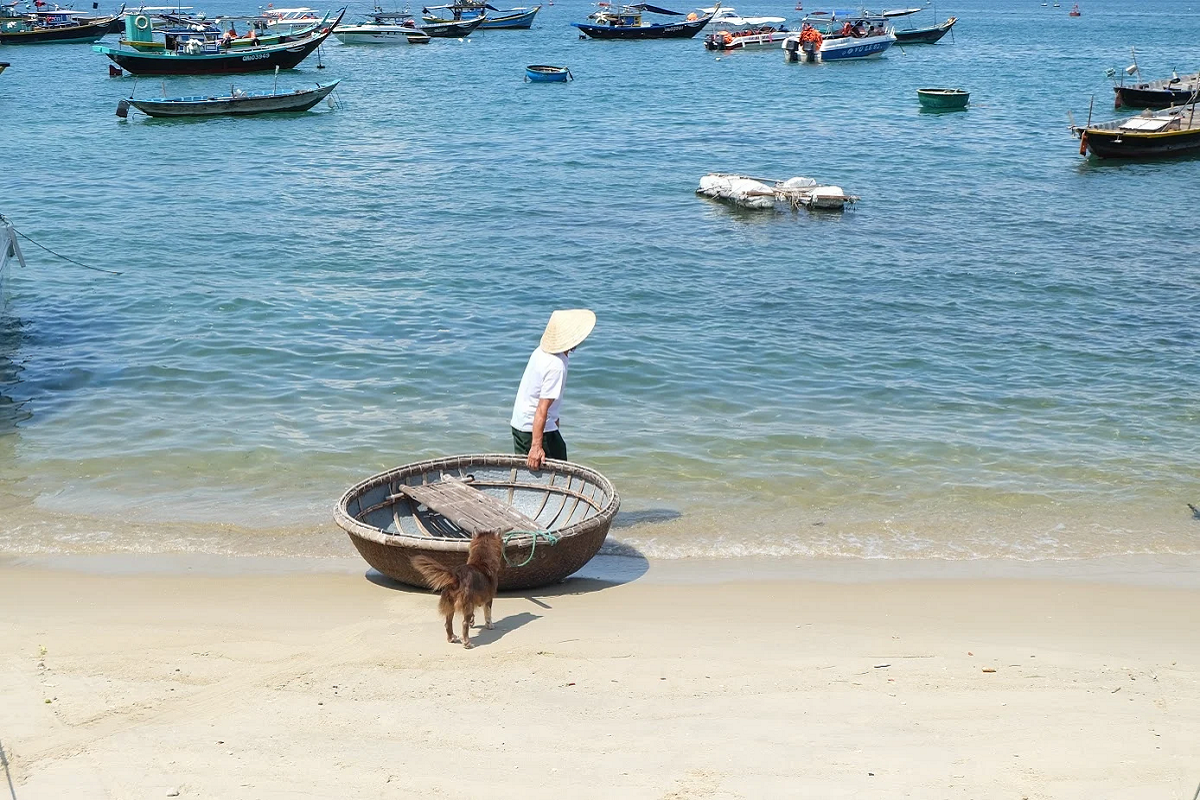
History of Cham Island
Ancient Times
Bai Ong (beach) archaeological site reveals the earliest presence of people in Cham Island and entire Hoi An, 3,100 BC. Archaeologists discovered fishing tools made by stone, pottery and traces of fire-wood kitchen. They said that these relics were left by inhabitants of Sa Huynh culture. If would like to know more about it, there is a museum within the Old town theme in it (near Japanese Bridge).
Champa Period
Questions about when the Chams came and how long they lived on the Island are still not clear yet. The strongest proof is the name of the archipelago, the Cham. Under the ground of the largest village today Bai Lang, archaeologists discovered artifacts related to the life of the people that dated back from 7th to 10th century. However, for them, the settlement time can be longer, from 2nd to 15th century.
During it, merchants from many countries in the world stopped here before going inland and trading in Champapura port (city of the Chams, currently Hoi An). Their main purposes were to buy food and freshwater. Arabian and Persian arrived first and found the right navigation to China later. Thanks to reuse by Viet people after being abandoned, Xom Cam well is the last standing remains from Cham’s period today. It features a circle mouth, stacked stone wall, ironwood and stone in the squared bottom. Water is still produced. Traces of a sophisticated irrigation network were seen in a close stream.
Hoi An Shipwreck
First Vietnamese families settled down on Cham Island in 16th century. For living, they planted rice in lowlands, catched fish and raised animals. Not long after their arrival, Hoi An town rose to become a major trading port in South-east Asia. It continued its leading role in maritime commerce till the early 19th century. Merchants from different continents came to it to seek silk, spices, prime porcelain and more. When moving across the sea near Cham Island, many boats crashed and sank.
In the 1990s, many high-quality pots were caught by local fisher’s nets and then they sold them in souvenir stores in the city center. More similar catches are seen shortly after, and a fever of antiquities occured. Knowing this, the police issued bans on the sale and researches soon were made on offshore waters of the Cham Island. Thanks to assistance from Oxford University and private enterprises, the first underwater excavation in history started.
From 1997 to 2000, 24,000 antiquities were carried ashore, including porcelain, ceramics, ironworks, stone sculptures and even human bones. Produced in kilns in North Vietnam by high techniques to export, all dated back from 15th and 16th centuries. Based on the teak wood, historians said that the boat was made in Thailand. Later, this huge collection was divided into smaller ones, and sent to large museums around the country. Visiting the Museum of Trade Ceramics if would like to see a portion.

Cham Island Weather & Best Time to Visit
The best time to visit Cham Island is the dry season, from February to the end of August. In these months, bad weather (such as typhoons, rains) is the minimum that allows outdoor activities and transports to be arranged safely. It features lots of sun, clear sky and warm waters. All are ideal to sightsee historical buildings, have fun at the beach, photograph and start discoveries under the sea. Visitors should bring sun cream, sunglasses, swimsuit, phone cover and cash. The freshest and most diverse seafoods are also catched, just awaiting to savour. If liking to lodge and be away from noisy cities, some seaside hamlets (like Bai Huong) are perfect.
From September to January, rains occur frequently and a rain poncho is the item that visitors usually have to bring. Together with the cold winds blowing from the north, the temperature decreases significantly. Called by locals “the wet or rainy season”, but sunny days are still possible to hope for. Asking the advice from local tour operators is top tip this time, because they know best what’s going on. From October to December, the worst weather happens when typhoons hit the area one by one. Stormy sky, big waves and strong winds appear and therefore, tours to Cham Island are cancelled because very dangerous or impossible to get there.


Cham Island Entrance Fee and Ticket
Each visitor will pay 70,000 VND for entry to Cham Island. Moreover, an addition of 30,000 VND is also surcharged, to raise funds for activities towards conservation, sustainable development and local community. In guided tours, these fees are covered. If traveling by yourself, you need to come to counters in harbours.

Activities in Cham Island
Visiting Historical Places in Bai Lang
Near the main harbour, Bai Lang is the most populous village. Thanks to the best conditions for living in Cham Island, its history of human settlement is from 3,100 BC (the earliest ever known in Hoi An). Today, this area owns many historical sites and some of which are included in the guided day tours. From the coast, the Cham Island Museum is the first sight and then Xom Cam Well, the only Cham survival. Locals believe that if drinking tea made from tree leaves from nearby forest and water from here, the seasickness stops. The last attraction in the walking tour usually is 18th-century Hai Tang Temple. To build, fishers had to transport materials from the mainland. Interestingly, there are no Buddhist monks there. Around the village, self-guided visitors can find small Whale shrines, ancestor tombs or a large monastery next to Hai Tang temple.
Activities at Bai Ong Beach
A short boat ride or walk from Bai Lang, Bai Ong Beach houses most things to do in Cham Island’s coastline. This 500m-long stretch of fine sand is fringed by clear and shallow water, with safe swimming zones, floating playground and some water sports. About the adrenaline games, it’s possible to expect paragliding, jet skiing, banana boat, surfing and stand up paddle boarding. All are excluded in tour prices. Players may pay from 800,000 to 1 million VND for a 15-minutes ride if they like to fly with a parachute or skim across the waters. Rescuers are always at work around, to help swimmers in trouble.
In the back, there are folding beach chairs, hammocks under shaded coconut palms and rustic bamboo restaurants. Free fresh water is available here, to wash and take a shower after in the sea. Camping and bonfire party are often organized in Bai Ong by local visitors. Rental price of a tent ranges from 100,000 to 200,000 VND.
Cham Island Snorkeling
No visitors want to miss this fantastic underwater activity on their day trip to Cham Island. It’s an inclusion in guided tours but also easy to book for self-guided trippers. Lifevest, swimming skills and no heart or respiratory problems are requirements. In common, it ends before lunch and lasts from 30 to 60 minutes, depending on the weather. After getting a swimsuit on, the boat will take snorkelers to legal coral reef spots inside the protection zone of the Cu Lao Cham Marine Park. There, just needing to wear the mask and jumping out, a rich and colorful world is shown before the eyes.
Cham Island offshore water is one of the most wealthy marine ecosystems in Vietnam. To discover more (and better) sites, travelers have to pay extra or book a tour specialized in snorkeling. The second option is available on the basis of one day or multiple days. Read our guide to Hoi An snorkeling for further details.
Visitors are not allowed to touch or pick up the corals, and smoke while being on board for safety reasons. Moreover, locals also advise to not swim near or stand on the oyster-covered rocks to minimize the injuries.
Cham Island Scuba Diving
Lots of visitors prefer snorkeling to diving in Cham Island day tours because it requires simpler skills and knowledge, and costs cheaper. Scuba diving gears and equipment are nearly always available in the boat but an announcement (booking) in advance should be made. If without, travelers need to let the guide know requirements soon, to arrange everything best possible. Remembering to make sense of the price before making the first discovery into Cham Island’s gorgeous coral gardens with an apparatus. However, local experts advise to buy a package in diving-specialized operators. Both day and multiple day trips are on offer. See the best time to dive in the year and the most reliable operators in our guide to Hoi An diving.
Cham Island Underwater Walking
There is only Sea Trek Vietnam organizing an underwater walk in the Cham Island today. This world’s largest organizer for the activity welcomes non-swimmers and no-divers from 8 to 80 years old. The shortest tour package lasts 7,5hrs from hotel pick up to drop off. The company recommends being in the lobby from 7:30 to 8 a.m and after meeting the guide, travelers are transported to Cua Dai harbour. A traditional wooden boat is chosen to get to Cham Island instead of a speed canoe. It takes one hour on the sea to get to the trekking area. There, the delight of the day, underwater walking experience begins. After additional swimming and snorkeling, the boat lands on a quiet beach where seafood lunch is served. Prior to returning to the mainland, travelers can relax on hammocks under the palms.
The price is 63 USD per person, around 1,450,000 VND. It covers all things mentioned in the itinerary, travel insurance and a GoPro to record fascinating walks under the sea. Parents will pay cheaper for little ones under 12 years old. A video about the whole trip is also sold with 250,000 VND. If staying in Da Nang, the bus picks up from 7 a.m. Browse seatrekvietnam.com for more details.
Touring the Island with a Motorbike
Travelers can pay 100,000 VND for a private ride on a motorcycle to tour around Cham Island. All riders are borned and live on the island, so they know their hometown well and highlights along the route. Scenic coast cruise, picture-perfect viewpoints, exotic landscape and seasonal flowers are what to expect. The price is fixed, regulated by the community. To start the drive, come to Tan Hiep market or ask your guide if joining an organized tour.
Buying Souvenirs & Fresh Seafoods
In the main harbour area, travelers can shop around to buy a souvenir to bring to the mainland. Shoppers have a variety of things to choose from, including accessories made by shells, dried seafoods, to local special products like partially dried squids, sweet cakes or forest leave tea. There are many seafood vendors on the side of the coastal road too, selling living fishes and shellfish only. For additional seafood dishes into the lunch meal, taking the favourites to any restaurant. Cooking fee is charged based on type and weight.
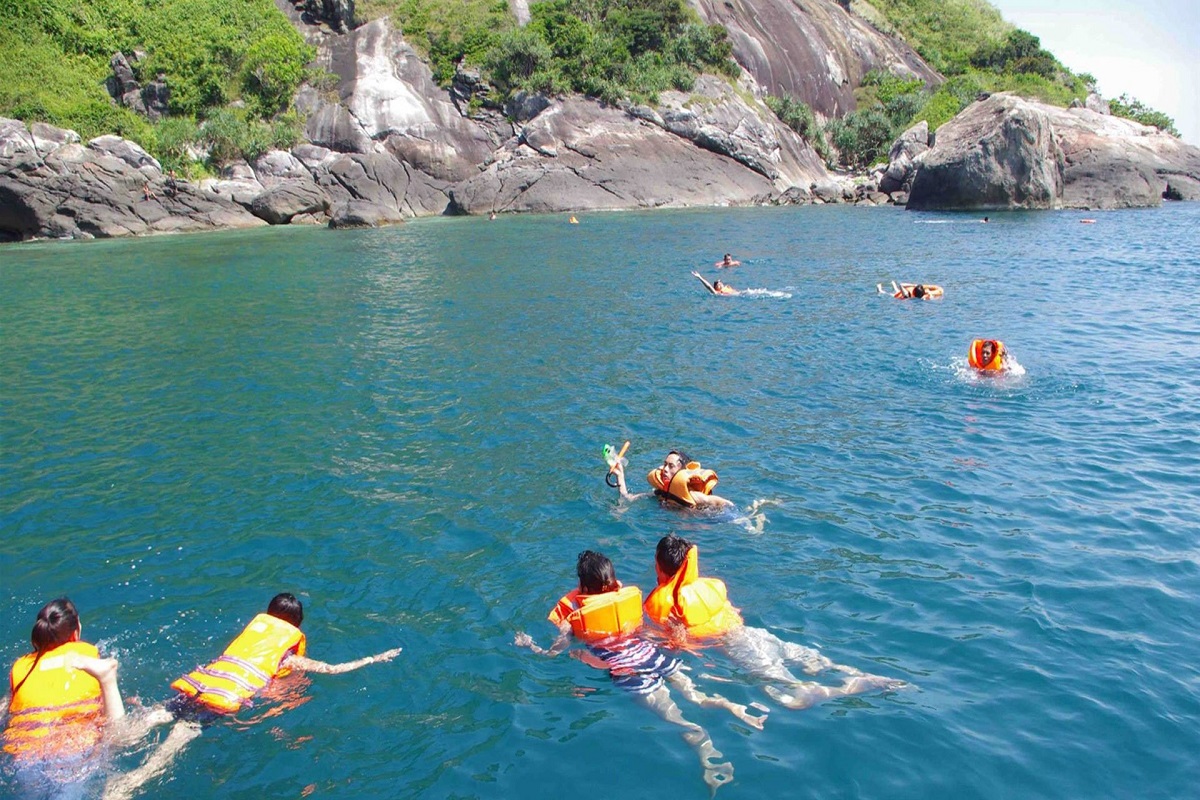

How to Get to Cham Island
Hoi An to Cham Island
Cham Island Speed Boat
Getting from Hoi An to Cham Island by speed boat is quickest. All boats dock, depart and return in Cua Dai tourist harbour, 9 km to the east of the city center. If staying overnight in Cua Dai Beach accommodations, the distance is much shorter. After boarding, it takes 20 to 30 minutes to arrive at Bai Lang harbour, depending on the weather. All organized tours cover a two-ways transport by a speed boat. Self-guided travelers will pay from 300,000 to 400,000 VND if returning on the same day, and from 400,000 to 500,000 VND if doing it later. It’s possible to book online via tour operators, hotels or directly in Cua Dai harbour. During the high season (summer), a reservation is really necessary to make.
Cham Island Ferry
Wooden boat ferry is the local option to get from Hoi An to Cham Island. In the morning, passengers can get on it in An Hoi Island between 7 and 7:30, or in Cua Dai tourist harbour between 8 and 8:30. The An Hoi’s harbour is at the end of a laneway next to the Hoi An Silk Marina Resort & Spa at 127 Nguyen Phuc Tan St. It’s easy to get from anywhere and any vehicle. The ferry cost is 150,000 VND and 100,000 VND respectively. If bringing your own bike to Cham Island, passengers will pay 50,000 VND extra. Travel time is around one hour. To return to the mainland, keep in mind to be in Bai Lang harbour between 11:30 and 12 p.m.
Besides ferry costs, tourists have to pay an admission fee for entry to the island. It’s 70,000 VND per person. Remember to prepare cash enough in the wallet.
Da Nang to Cham Island
Travelers staying in Da Nang prefer to get to Cham Island by speed boat because of the long distance to Hoi An’s harbours. Self-guided ones often book a taxi/car transfer from the hotel, costing around 250,000 VND (if departing from downtown) or ride an own motorcycle. The second vehicle requires a one day rental. It takes 40 minutes by car and around 1 hour by bike. The easiest road to get the speed boat harbour is the Coast Road Vo Nguyen Giap – Truong Sa. Following it until its end, the entrance and parking lots are to the right.
Because the boat returns in mid-afternoon, a basket boat ride in Hoi An Coconut Village or a walking tour around lantern quarters of the Old Town is the choice to continue the day of exploration. At night, the quickest route Lac Long Quan Rd has lights, so don’t worry about traffic safety after it’s dark. Hoi An’s ancient town is a paradise of street food and classy restaurants to dine out.
Both Da Nang- and Hoi An-based travel agencies arrange tours with a round trip transfer from hotel. Departure time is one hour earlier in Da Nang.


Cham Island Tour
Cham Island Tour from Hoi An
The most popular Cham Island tour from Hoi An is a day trip. It departs from Cua Dai harbour and then a speed boat will take travelers to Bai Lang, the largest village in the Island. There, a walking tour to historical places around it is the first activity. At each stop, the local guide introduces and explains different things. He/she may speak Vietnamese better than English, but can understand the traveler’s requirements. During the walk, there are many chances to buy souvenirs and living seafood.
After that, the canoe brings the group to a sandy beach, to get in a swimsuit prior to riding to the snorkeling spot. Masks are provided there. Travelers often have at least 40 minutes to see marine life. Lunch in a bamboo restaurant is served then, featuring a shared meal with steamed rice, seafoods and some island specialties. Before returning to the mainland (around 3 p.m), a free time is made to allow travelers to swim, sunbathe, join water sports or just relax on the chairs under the palms.
Note: Price of the itinerary described above costs 650,000 VND. This is the official one and is higher if including a two-ways transfer from the hotel. Picking up in Da Nang is easy to arrange for any operator.
Cham Island Snorkeling Tour
Snorkeling experience in common day tours is from 40 to 60 minutes, in a spot. Because it is visited by many people daily (up to some thousands in peak time), the marine life and coral reefs in this snorkeling place is quite disturbed. If it requires a trip which is longer, more sites and little spoiled, a snorkeling-specialized package is suitable. For those who love staying overnight in peaceful Cham Island at night, multi-day options are available. See the best organizers, their tours and more in our travel guide to Hoi An snorkeling.
Da Nang’s peninsula and island also house stunning snorkeling spots. See information about all of them and a comparison to Cham Island here.
Cham Island Diving Tour
Compared to a common day tour, a packaged trip with a focus on diving provides more dive sites and better experiences there. All necessary equipment and gears are available, to allow divers to have safe, fun and fascinating discoveries in nearly untouched coral gardens. Travelers can spend a few days in Cham Island to explore every side of it, from the undersea to the mountaintop. Read our guide about Hoi An diving to know the best operators, their tours, advice and tips.
Fishing Tour with Local Fisherman
Fishing tours are also available in Cham Island. If don’t stay overnight there, travelers can book a package departing from the city. To get to the most ideal spots to throw the rod, a local fisherman will propel his own wooden boat. A day tour aims to catch fishes, while in the evening one, squid is the focus (seasonal). See more information in our guide to Hoi An’s fishing tours.


Cham Island Restaurants
Cham Island Food Specialties
Cham Island is famous for many food specialties, and while visiting it, travelers can try some of them. In the set-menu lunch of beachfront restaurants, cellana (“lady chest snail” or oc vu vang), banh it la gai (ramie cake with a coconut filling) and forest vegetables are included. When walking near the harbour, it’s possible to see local women making muc mot nang (partially dried squids) on iron nets. If staying overnight, the host family may take the guests to streams where cua da (stone crabs) can be caught. Locals love to steam them with spices, and then eat with a black pepper salt. This species is not recommended to eat because it’s quite rare in the wild now. Last but not least, the edible bird’s nests are the most expensive. Locals harvest them in cliff caves in the southeasternmost tip of Hon Lao.
Restaurants in Cham Island
In Bai Ong, Bai Lang and Bai Chong, three touristy beaches, travelers can see restaurants and eateries to eat. Places in Bai Ong and Bai Chong are popular for day tours, so often open in the daytime only. Price of set menu meals there (for 4 people) is cheaper if booking via a company, ranging from 100,000 to 200,000 VND pp. Steamed rice, seafood, salad, soup, fresh fruit and local sweet cake as a dessert will come to the table. On the other hand, seafood lovers can buy fresh ingredients, bring them to kitchens and ask the cooks to make their favorite recipes. The preparation fee is counted based on type and weight. It’s possible to get there by walking or riding a motorcycle from the main village.
If staying overnight, travelers can go to Bai Lang seafront or enjoy a family dinner in the homestay. In the morning, authentic breakfast dishes are sold around Tan Hiep market (near main harbour), such as mi quang noodles, banh mi. We recommend “stayers” to read our guide for Cham Island accommodation to get details.
Cham Island Accommodation
Cham Island is an awesome place to stay in Hoi An, firstly, because of its isolation from the mainland. Thanks to that, travelers can enjoy a sense of serenity throughout the day, especially at night. Most options are within an authentic fisherman community that is next to the sandy beach where a killer sunset occurs daily, well-kept forests and historical sites. The guests only need a few minutes to get to scenic dive sites, to join Hoi An’s best underwater activities. Homestays are not hard to search and the owner families are willing to invite new friends to eat with all members. These are what travelers find in their escape from the hustle and bustle. Read our traveler guide to Cham Island Accommodation to know the best areas to book a room, and reasons to explain why.
Cham Island on Google Maps
Related Posts
Bach Ma National Park: Hiking, Trekking in Da Nang and Hoi An
Two best places for trekking and hiking in and near Da Nang are Son Tra mountain (peninsula) and Bach Ma national park. Which one is better is actually personal because these
Hoi An Wet Season: What to Do in Hoi An When It Rains?
No beach, no pool, no outdoor adventures? What to do in Hoi An when it rains? This is a very popular question from travelers who come to Vietnam in the
Thanh Ha Terracotta Park
Between 15th and 19th centuries, Hoi An was one of major stopovers for sailing merchants to trade in Southeast Asia. Meanwhile, craftspeople in its Thanh Ha village produce high-quality pottery
Vinwonders Nam Hoi An Theme Park (formerly Vinpearl Nam Hoi An)
In addition to historical and cultural attractions, nowadays Hoi An also has a couple of amusement parks to entertain. Definitely, they’re ideal places for families with children and groups of
Am Phu Cave (Hell Cave) – Things to Do in Da Nang
Although in the Marble mountains – the most visited attraction in Da Nang, travelers often miss Am Phu cave. One of reasons is that it’s mentioned much online and not
Hoi An or Hue: Which is Better?
Both Hoi An and Hue cities are in the middle of Vietnam, and they’re not far from each other (about 130 km). Therefore, for those who travel from north to
The Official Hoi An Travel Guide (MUST READ)
By the estuary of Thu Bon river, Hoi An is one of the best places to visit in Vietnam. This Vietnamese town is a package for travelers – a pretty
The Hoi An Market (Hoi An Central Market) Complete Guide
The Hoi An Market is the first market in Hoi An ever. Over centuries, it’s still the largest market in town although the town has a much bigger size than
Hoi An Memories Show: The Best of Hoi An Impression Theme Park
The Hoi An Memories Show is a famous series of outdoor performances in Hoi An at the present time. Thanks to its exceptional production and great cultural stories, it becomes
Hoi An Bridge: Famous Bridges in Hoi An
Hoi An has many bridges because it’s located at the confluence of 3 rivers: Thu Bon river, De Vong river and Truong Giang “Long river”. The distributaries of these rivers
How to Get From Hoi An to My Son Sanctuary
My Son sanctuary is one of the most popular places to visit for tourists staying overnight in Hoi An, especially those who spend many days there. It’s known for a
Hoi An’s Chinese Assembly Halls and Chinese Temples
Chinese people migrated to Hoi An from the early 17th century. Today, Chinese communities as a whole are the second most important piece to form the town’s unique culture. The foremost
Hoi An Walking Tours: Heritage, Foods, Photography & Locals
Strolling around heritage quarters with a local guide is the activity that so many travelers love to do in Hoi An. It enriches their time in this lovely town. Firstly,
Hoi An Self Guided Walking Tour – Hoi An On Your Own
Hoi An old town is friendly for pedestrians, especially during the time that motorized vehicles (scooters, cars, etc) are prohibited to move around its heritage quarters. That is safe for
How to Visit Golden Bridge Vietnam
The Golden Hand Bridge of Ba Na hills today is a dream place to visit for many travelers. Since it opened in June 2018, millions of people have set their
Unique Experiences in Hoi An and Why?
Today, travelers seek more experiences in the destination they go to. They want to have a deeper understanding about the culture of local people and interact with them. No other
An Bang Beach: A Guide to Hoi An’s Best Beach
An Bang beach now becomes a popular tourist attraction in Hoi An. It may be the best known and most convenient to reach from the town’s centre. Not only tourists,
Experiences in Hoi An: Get Insight Into Hoi An’s Local Culture
As the most unique Vietnamese town, Hoi An is definitely worth visiting. Here, visitors have many things to do and experiences for their holiday time. Everyone knows that it has
Things to Do in Ba Na Hills Besides Golden Bridge
According to local authorities, 50% of visitors coming to Da Nang and Hoi An visit the Ba Na hills. In other words, that is nearly 10 millions of people. This
Hoi An Nightlife: What to Do in Hoi An At Night?
After dark, Hoi An becomes exceptionally spectacular. If planning to stay overnight or visiting this ancient heritage town, at least travelers know that it’s “decorated” by so many colorful lanterns.
Hoi An Countryside: Villages, Rice Fields & Tours
By the coast, Hoi An is at the confluence of 3 rivers: Thu Bon river, Truong Giang river and De Vong river. This economically strategic location has supported trading activities
How to Get to Golden Bridge From Hoi An
There are many travelers visiting the Golden bridge from Hoi An. Both the bridge and the town today are must-see places in the region, so staying overnight in the town
Hoi An Entrance Fee: Old Town, Golden Bridge, My Son, More
Are you planning to visit Hoi An? And you don’t know how much cash you need to prepare for visiting places? This article lists tourist attractions in Hoi An and
Hoi An Airport: Everything You Need to Know
Hoi An is a famous tourist city in Vietnam. It’s 800 kilometers away from Hanoi, the capital of Vietnam and nearly 1,000 kilometers from Ho Chi Minh city, the biggest
Hoi An Lantern Boat Ride on Hoai River
A lantern boat ride is a thing to do that visitors must do today in Hoi An. For many centuries, locals have taken it on the Hoai river by the
Hoi An Private Car and Driver
Hoi An is one of the most popular tourist destinations in Vietnam. In the busiest year, it attracts about 9 millions visitors who come to enjoy its charming beauty, rich
What to Do in Hoi An Ancient Town
Hoi An Ancient Town is a must see, not only thanks to its world heritage title, but also to its vintage urban landscape, lots of attractions and activities. In the
Da Nang and Hoi An Itinerary for Visitors Staying Overnight in Hoi An
Da Nang and Hoi An are twin cities in the heart of Central Vietnam. Both are popular tourist destinations for either domestic or international visitors, and share many similarities. Due
Hoi An 3 Day Itinerary: A Travel Plan for 3 Days in Hoi An
3 days are a perfect duration to stay overnight in Hoi An and explore captivating places in and around it. Especially for those who travel from city to city or
Hoi An Free Things to Do: Budget Travel in Hoi An Vietnam
Travelers should know free things to do in Hoi An, to save the budget for this wonderful city and by that, can stay longer to explore. From old town, countryside
Hoi An One Day Itinerary: A Travel Plan for One Day in Hoi An
From a backwater town in the 1990s, Hoi An today is one of leading tourist destinations across Vietnam. In a recent year, it attracted 8,5 millions of overnight visitors and
Hoi An Half-Day Tours: Guide to Half Day Trips From Hoi An
Top attractions near Hoi An require a couple of hours or half a day, to get there and visit around. The reason is that all have many things to see,
Hoi An Day Tours: A Guide to Best Day Trips From Hoi An
Near Hoi An, there are many fantastic places making travelers can’t stay in the room and have to go out to explore. Appeal Golden bridge – the new world wonder,
Hoi An Beach: A Guide to All Beaches in Hoi An Vietnam
Not only an old town, Hoi An has beaches as well! That are sandy, edged by tropical water and lined by palm forests. Travelers don’t need to wait or move
Hoi An Food Specialties
Hoi An is a melting pot where people from different parts of Vietnam and countries in the world have gathered and exchanged their cultures. As a result, this town has
How to Get From Hoi An to Da Nang
Da Nang is the neighbouring city of Hoi An. It's the capital of Central Vietnam and has the most important (busiest) transport hubs of the region, such as airport, train
Hoi An Cheap Things to Do: All Solo Travelers Need to Know
Knowing free and cheap things to do in the city where travelers are going to visit, is helpful. First of all, they can save and, thanks to that, can stretch
Hoi An Best Things To Do: Recommendations from Local Experts
It is no coincidence that Hoi An is in the list of must-visit places once in the lifetime of many travelers. Located by a river, it’s borned to welcome people
Hoi An Things to Do: All What Can You Do in Hoi An Vietnam
Hoi An is in the bucket list of most travellers who plan to visit the Central part of Vietnam. It’s a lovely old and small town located downstream of a
Hoi An Things Not to Miss: A Guide to Must Do in Hoi An
In fact, there are so many things to do in Hoi An, one of the 10 best cities in Asia by Travel + Leisure in 2021. It has a lantern-filled
Hoi An or Da Nang: Which is Better for First Time Visitor?
Da Nang and Hoi An are located in Central Vietnam, with a distance of roughly 30 km. To the north, Da Nang is the capital city of the region, with
Hoi An Pottery Village: A Guide to Thanh Ha Pottery Village
Hoi An used to be a bustling, prosperous trade port during past centuries, before its role was replaced by Da Nang. Merchants from many countries on different continents came here
Hoi An Ancient Town Tour
Hoi An Ancient Town is a Unesco world heritage site by the mouth of the Thu Bon River. It has grid-plan streets filled by silk lanterns and bougainvillea flowers that
Hoi An Old Town Ticket: Price, Sellers, Included Sites, More
As an attraction including attractions, Hoi An Old Town requires an entrance ticket to tourists who come from other parts of Vietnam and the world. It raises funds for preservation of
My Son Sanctuary Tour
My Son Sanctuary is a Unesco world heritage site, attracting 450,000 visitors in recent years. It’s the best remains left by the fallen Champa Kingdom which ruled a part of
Hoi An Lanterns: Festival, Making Class, Where to Buy, More
Lanterns are the signature of Hoi An Old Town, the 3rd Unesco world heritage site in Vietnam. Especially at night, these traditional handicraft objects are lit up and make the town
Hoi An Best Area to Stay: Guide to Where to Stay in Hoi An
In the busiest year, nearly 5,5 millions travellers decided to stay overnight in Hoi An. It’s the largest number that a city in the Central coast of Vietnam ever achieved.
Hoi An Weather by Month: Guide to Hoi An Monthly Weather
Hoi An won the title “Asia’s leading cultural destination” recently in a reputable global travel award. It’s a pretty riverine-coastal town with an ancient root, surrounded by peaceful pieces of
Hoi An River Cruise: Guide to The Best Boat Tour in Hoi An
Hoi An town is by the left bank of the Thu Bon River, and by that, it draws plenty of merchants by sailing boat to visit and trade. Its golden
Hoi An Old Town Boats: Guide to Boat Rides in Hoi An Town
Hoi An town sits by the left bank of the Thu Bon River, the largest and most important waterway in mother Quang Nam province. It’s also near the mouth of
Hoi An 2 Day Itinerary: Traveler Guide to 2 Days in Hoi An
2 days are enough to know the highlights in Hoi An, a famous tourist destination in Central Vietnam. And for those who travel from city to city, 48 hours are
Cham Island Hoi An
The purple islands seen from An Bang or Cua Dai beaches are the Cham Islands. It’s one of the kind in the region where God bless it with fabulous beautiful
Hoi An Basket Boat Ride
Nowhere else outside of Hoi An Coconut Village, travelers can find a basket boat ride across the immense palm forests. It’s an experience that allows the passengers to know better
Hoi An Coconut Village: A Guide to Cam Thanh Coconut Village
Hoi An Coconut Village boasts of the most interlaced waterway system in the city. Four rivers encircle it and are connected together with smaller canals. Thanks to fertile alluvia and
Hoi An Cham Temples: My Son Sanctuary & Quang Nam Temples
Cham people settled in Hoi An before the Vietnamese arrived and handed it over in 14th century. Influenced by Indian culture, they called the land “Amaravati”, similar name to a
How to Get from Da Nang Airport to Hoi An
Located in the city of the same name, Da Nang airport is the nearest airport to Hoi An. So, if travelers want to see an extremely-colorful Lantern festival or try
Da Nang to Hoi An: Best Da Nang Airport Transfer and More
If traveling to Hoi An by air, train and cruise ship, visitors will come to Da Nang first and then have a transfer. The largest city of Central Vietnam holds
Hoi An Tour Guide: How to Find a Private Tour Guide in Hoi An
Most tour packages in Hoi An cover “ a guide”. He or she may be the first and closest local to the visitors, who lead the group to enjoy the
Hoi An Ancient Town Attractions
Spreading over an area of 30 hectares, Hoi An Old Town owns more than 1,100 timber buildings varying in function or type. In the oldest street, the Japanese bridge spans
Hoi An Old Town Map
There are so many things to see, do, eat and sleep in Hoi An Old Town, so the visitors often are confused while planning and exploring. Starting the research from


